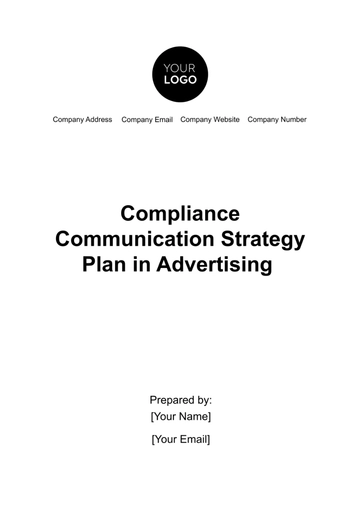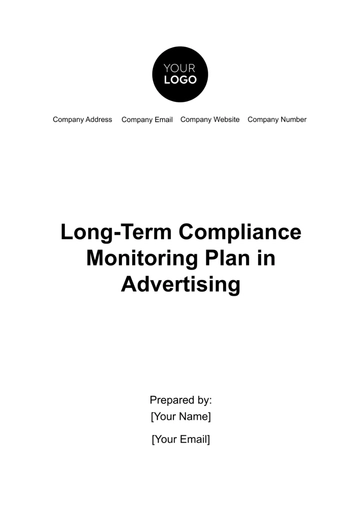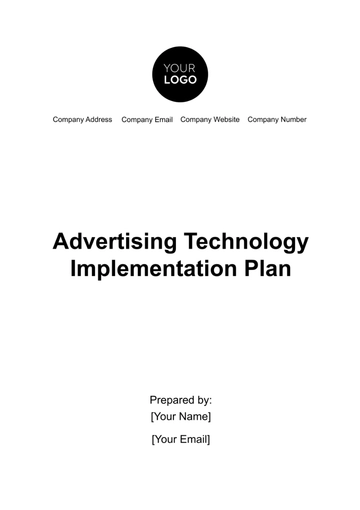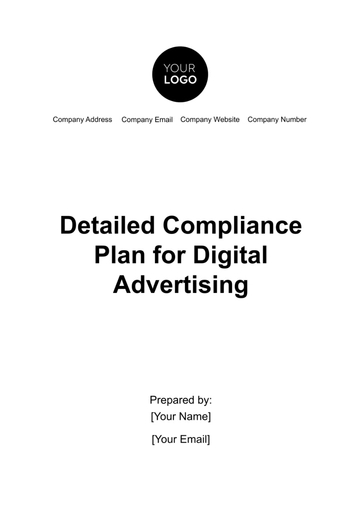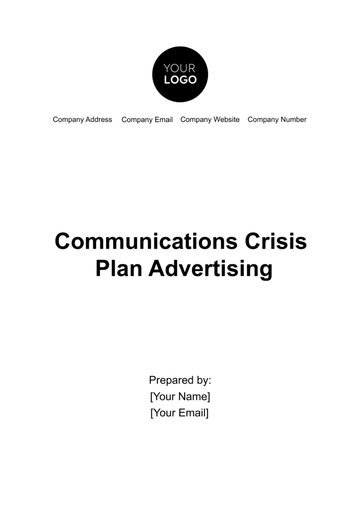Free Event Crisis Management Advertising Plan

1. Introduction
In today's fast-paced and often unpredictable event advertising landscape, the ability to swiftly and effectively manage crises is not just beneficial, it's imperative. Recognizing this critical need, [Your Company Name] has meticulously developed a comprehensive Event Crisis Management Advertising Plan. This plan serves as a strategic blueprint, empowering you to navigate through and effectively mitigate the myriad of challenges that may arise during the lifecycle of an event.
Our plan is built on a foundation of thorough risk assessment and scenario planning. It encompasses a broad spectrum of potential crises, from technological failures and security breaches to natural disasters and other unforeseen events that could impact your advertising efforts. The key to successful crisis management lies in preparedness and flexibility. Therefore, our plan is designed to offer both proactive and reactive strategies, providing you with the tools and guidance necessary to maintain control and decisiveness in the face of adversity.
Proactive measures include rigorous pre-event planning, stakeholder education, and establishing clear communication channels. Reactively, the plan details effective response mechanisms to quickly address and mitigate crises as they unfold, ensuring minimal disruption to your event. Through this comprehensive approach, we aim to preserve not only the integrity and continuity of your event but also safeguard your brand's reputation.
At [Your Company Name], we understand that the unpredictable nature of events requires robust and adaptable strategies. Our Event Crisis Management Advertising Plan is crafted to give you confidence and control, ensuring that no matter what challenges arise, your event can proceed with minimal impact and maximum success. This plan is your assurance that, in the realm of event advertising, you are fully equipped to turn potential crises into well-managed situations.
2. Crisis Identification and Analysis
To formulate an effective Event Crisis Management Advertising Plan, it is crucial to first identify and understand the potential crises that could impact the event. [Your Company Name] has conducted a detailed analysis of potential crises, assessing both their likelihood and the level of impact they could have on event advertising. This analysis is instrumental in guiding our preparation and response strategies.
Detailed Crisis Analysis:
Year | Potential Crisis | Likelihood (%) | Impact Level |
2050 | Technological Failures | 20 | High |
Natural Disasters | |||
Security Threats |
Technological Failures (2050): With a 20% likelihood, technological failures pose a significant risk. This includes breakdowns in digital advertising platforms, failures in event technology, or data breaches. The impact is rated as high due to the integral role technology plays in modern event advertising and management.
Natural Disasters (2051): Although less likely at 10%, the impact of natural disasters such as floods, earthquakes, or severe weather events is rated as very high. These can lead to the cancellation or significant disruption of the event, requiring extensive crisis communication and contingency planning.
Security Threats (2052): Security threats, including cyber-attacks or physical threats at the event, have a 15% likelihood of occurrence. These pose a high impact due to the potential harm to attendees, data breaches, or reputational damage, necessitating robust security measures and crisis management protocols.
Analysis Application
This analysis is foundational in developing targeted mitigation strategies. By understanding the nature and potential impact of each crisis, [Your Company Name] can devise specific plans to address these challenges proactively. This includes establishing robust backup systems, comprehensive security measures, and detailed contingency plans. Our approach ensures that should any of these crises arise, we are well-prepared to respond effectively, minimizing disruption and safeguarding the event's success and the brand's reputation.
3. Communication Strategy
In today's fast-paced and interconnected business environment, a well-crafted communication strategy is vital for any organization. Effective communication is not only essential during periods of stability but also becomes paramount during times of crisis. This chapter delves into the intricacies of a comprehensive communication strategy, outlining key principles and practices that can help your organization navigate the turbulent waters of a crisis successfully.
1. Pre-Crisis Communication:
Before a crisis strikes, it is imperative to establish a robust communication framework that will serve as the foundation for all future interactions with stakeholders and the public. This framework should not only be proactive but also designed to inform, reassure, and prepare both internal and external audiences.
A proactive approach involves continuously monitoring the external environment for potential risks and emerging threats. By staying ahead of the curve, organizations can anticipate issues before they escalate into a full-blown crisis. Once these risks are identified, communication plans must be developed to address them effectively.
The preparedness measures within the pre-crisis communication strategy encompass creating clear and concise messages that can be disseminated rapidly when needed. Establishing designated spokespersons and communication channels ensures that information flows smoothly within the organization and to the relevant external parties. Additionally, regular drills and training exercises can help ensure that all stakeholders are familiar with their roles and responsibilities during a crisis, minimizing confusion and delays.
2. During Crisis:
When a crisis is underway, the ability to communicate effectively becomes even more critical. During these challenging times, organizations must implement real-time communication channels that provide accurate and timely updates, clear instructions, and reassurances to all concerned parties.
Social media platforms, press releases, and direct communication with attendees and partners are some of the primary tools that can be employed to disseminate information rapidly. These channels should be utilized strategically, taking into account the preferences and expectations of the target audience.
Transparency is paramount during a crisis, and organizations should strive to provide honest and forthright information to the public. While maintaining transparency, it is also essential to exhibit empathy and understanding towards those affected by the crisis. Demonstrating genuine concern can go a long way in building trust and goodwill.
3. Post-Crisis:
Once the crisis has passed, the communication strategy should pivot towards addressing the aftermath. This phase involves a thorough evaluation of the organization's response to the crisis, focusing on lessons learned and identifying areas for improvement.
Transparent communication remains crucial as organizations must account for their actions during the crisis and communicate any corrective measures being taken to prevent a recurrence. The post-crisis communication should emphasize the organization's commitment to learning from the experience and implementing changes that enhance future preparedness.
A well-defined communication strategy is not just a business necessity; it is a lifeline during crises. By proactively addressing potential risks, communicating effectively during a crisis, and learning from the experience afterward, organizations can strengthen their resilience and maintain the trust of their stakeholders and the public. This chapter serves as a guide to crafting and implementing a comprehensive communication strategy that can withstand the most challenging of circumstances.
4. Budget Allocation for Crisis Management
A well-prepared Event Crisis Management Advertising Plan is crucial to navigate unforeseen challenges and ensure the safety and satisfaction of attendees and stakeholders. This chapter focuses on one critical element of crisis management: budget allocation. Specifically, it outlines the various items that constitute the Crisis Management Budget and estimates their costs.
Item | Estimated Cost |
Crisis Communication Team | [$1,000] |
Emergency Resources | |
Technology Backup Systems |
Budget Allocation for Crisis Management
Crisis Communication Team
Estimated Cost: [$0,000.00]
The Crisis Communication Team is the backbone of an effective crisis management strategy. Comprising skilled professionals in public relations, communication, and crisis response, this team plays a pivotal role in managing and mitigating the impact of any crisis that may arise during the event. Their responsibilities include monitoring the situation, crafting and disseminating timely and accurate messages, and coordinating with various stakeholders.
The allocated budget for the Crisis Communication Team encompasses salaries, training, and any external resources or consultants that may be required. Investing in a proficient team is a fundamental step in ensuring that the event can respond swiftly and effectively to any crisis scenario.
Emergency Resources
Estimated Cost: [$0,000.00]
In the face of a crisis, having access to essential emergency resources is paramount. This category includes items such as first aid kits, emergency medical supplies, fire extinguishers, and evacuation equipment. Depending on the scale and nature of the event, the types and quantities of emergency resources required may vary. It is essential to allocate a budget for procuring, maintaining, and replenishing these resources as needed.
Additionally, training personnel in the proper use of these resources is equally important. The allocated budget should cover training sessions, certifications, and drills to ensure that the event staff can respond effectively to emergencies.
Technology Backup Systems
Estimated Cost: [$0,000.00]
In today's digitally-driven world, technology plays a vital role in event management and communication. However, technology can also be vulnerable to disruptions, which is why it is essential to allocate a budget for technology backup systems. These systems include redundant servers, data backup solutions, communication infrastructure, and power backup (such as generators or uninterruptible power supplies).
The estimated cost for technology backup systems should cover the purchase, installation, and maintenance of these systems. Ensuring the reliability and continuity of technology infrastructure is critical for maintaining effective communication and response capabilities during a crisis.
Total Crisis Management Budget: [$00,000.00]
Allocating a budget for crisis management is a strategic investment that safeguards the success and safety of any event. The items outlined in this chapter represent key components of the Crisis Management Budget, ensuring that the event has the necessary resources, personnel, and technology in place to address and mitigate crises effectively. By allocating funds to these critical areas, event organizers can enhance their preparedness and response capabilities, ultimately providing attendees and stakeholders with the confidence that their safety and well-being are a top priority.
5. Monitoring and Evaluation
Effective crisis management extends beyond the initial response; it requires continuous vigilance and a commitment to ongoing improvement. In this regard, the fifth component of the crisis management plan focuses on "Monitoring and Evaluation." This critical phase involves implementing real-time monitoring systems to promptly detect and gauge the seriousness of any emerging crisis, as well as conducting regular evaluations of communication and intervention strategies to facilitate swift adjustments and enhancements.
1. Real-time Monitoring Systems:
To proactively address emerging crises, organizations must establish robust real-time monitoring systems. These systems involve the continuous surveillance of various data sources, including social media, news outlets, and internal reports, to swiftly identify any potential threats or issues that could escalate into crises. By utilizing advanced analytics tools and AI-driven algorithms, organizations can not only detect crises early but also assess their severity and potential impact accurately.
Moreover, real-time monitoring systems can provide valuable insights into public sentiment and perception, enabling organizations to tailor their communication strategies accordingly. The ability to identify emerging trends and concerns empowers crisis management teams to respond promptly and with greater precision, ultimately minimizing the damage and reputation fallout that crises can bring.
2. Regular Evaluation of Effectiveness:
Equally crucial is the practice of regular evaluation. Crisis management is an evolving process, and the strategies and tactics employed must be subject to continuous assessment. This entails conducting post-crisis debriefings to analyze what worked well and what could have been improved. Furthermore, organizations should assess their response times, the accuracy of their communication, and the effectiveness of their intervention measures.
The insights gained from these evaluations serve as the foundation for making swift adjustments and improvements to the crisis management plan. By adopting a proactive stance towards evaluating their crisis response efforts, organizations can refine their strategies, enhance their preparedness, and strengthen their resilience to future crises. This iterative approach ensures that the organization is not only capable of responding to crises effectively but is also committed to learning and adapting in an ever-changing landscape.
6. Post-Crisis Strategy
A well-crafted post-crisis strategy is indispensable for an organization seeking to recover from the aftermath of a crisis effectively. This phase, often overlooked but of paramount importance, revolves around three core elements: damage control, reassessment of advertising strategies, and rebuilding trust and reputation.
1. Damage Control:
In the immediate aftermath of a crisis, it's crucial to assess and address the extent of the damage incurred. This assessment encompasses not only the tangible aspects such as financial losses and physical damages but also the intangible, including the impact on the organization's brand and reputation. An organization should have a dedicated team responsible for conducting a thorough post-crisis audit. This involves evaluating the effectiveness of the crisis response, identifying any shortcomings, and determining the root causes that led to the crisis in the first place.
Once the assessment is complete, the organization can initiate a strategic damage control plan. This plan should outline steps to mitigate the negative consequences of the crisis, both in terms of tangible losses and reputation damage. It may involve public statements, compensation to affected parties, and any necessary legal actions. Swift and transparent communication is key during this phase, as it demonstrates the organization's commitment to resolving the crisis and its dedication to making amends.
2. Reassessment of Advertising Strategies:
The post-crisis period is an opportune time to reassess and potentially recalibrate advertising strategies. It's essential to evaluate whether the pre-crisis advertising strategies are still appropriate given the changed circumstances and public perception. This may involve redefining target audiences, revising messaging to align with the organization's values and commitment to improvement, and adjusting advertising channels to regain consumer trust.
Moreover, organizations should consider incorporating crisis communication into their advertising strategies. Addressing the crisis openly and honestly in advertising campaigns can demonstrate transparency and a commitment to learning from past mistakes. It's an opportunity to showcase the organization's resilience and dedication to making necessary changes.
3. Rebuilding Trust and Reputation:
Rebuilding trust and reputation is a long-term endeavor that requires consistency and sincerity. Organizations should focus on rebuilding trust both internally among employees and externally with customers, partners, and stakeholders. This may involve implementing new policies and procedures to prevent future crises, ongoing communication efforts to keep stakeholders informed of progress, and initiatives that demonstrate the organization's commitment to positive change.
To regain public trust and rebuild its reputation, an organization should engage in socially responsible activities and align its actions with its stated values.
7. Conclusion
This Event Crisis Management Advertising Plan by [Your Company Name] is an essential guide for navigating through challenges with resilience and efficiency. Our approach ensures that your event remains robust against potential crises, safeguarding its success and your brand's reputation.
8. Contact Information
[Your Name]
Email: [Your Email Address]
Phone: [Your User Phone]
For further assistance in crisis management and event advertising, contact [Your Company Name]. Our expertise is your peace of mind.
- 100% Customizable, free editor
- Access 1 Million+ Templates, photo’s & graphics
- Download or share as a template
- Click and replace photos, graphics, text, backgrounds
- Resize, crop, AI write & more
- Access advanced editor
Introducing Template.net's Event Crisis Management Advertising Plan Template. This editable and customizable tool, powered by our Ai Editor Tool, offers a structured approach to handle crises during events. From risk assessment to communication strategies, mitigate potential disruptions effectively. Safeguard your event's success with Template.net's comprehensive crisis management solutions.
You may also like
- Finance Plan
- Construction Plan
- Sales Plan
- Development Plan
- Career Plan
- Budget Plan
- HR Plan
- Education Plan
- Transition Plan
- Work Plan
- Training Plan
- Communication Plan
- Operation Plan
- Health And Safety Plan
- Strategy Plan
- Professional Development Plan
- Advertising Plan
- Risk Management Plan
- Restaurant Plan
- School Plan
- Nursing Home Patient Care Plan
- Nursing Care Plan
- Plan Event
- Startup Plan
- Social Media Plan
- Staffing Plan
- Annual Plan
- Content Plan
- Payment Plan
- Implementation Plan
- Hotel Plan
- Workout Plan
- Accounting Plan
- Campaign Plan
- Essay Plan
- 30 60 90 Day Plan
- Research Plan
- Recruitment Plan
- 90 Day Plan
- Quarterly Plan
- Emergency Plan
- 5 Year Plan
- Gym Plan
- Personal Plan
- IT and Software Plan
- Treatment Plan
- Real Estate Plan
- Law Firm Plan
- Healthcare Plan
- Improvement Plan
- Media Plan
- 5 Year Business Plan
- Learning Plan
- Marketing Campaign Plan
- Travel Agency Plan
- Cleaning Services Plan
- Interior Design Plan
- Performance Plan
- PR Plan
- Birth Plan
- Life Plan
- SEO Plan
- Disaster Recovery Plan
- Continuity Plan
- Launch Plan
- Legal Plan
- Behavior Plan
- Performance Improvement Plan
- Salon Plan
- Security Plan
- Security Management Plan
- Employee Development Plan
- Quality Plan
- Service Improvement Plan
- Growth Plan
- Incident Response Plan
- Basketball Plan
- Emergency Action Plan
- Product Launch Plan
- Spa Plan
- Employee Training Plan
- Data Analysis Plan
- Employee Action Plan
- Territory Plan
- Audit Plan
- Classroom Plan
- Activity Plan
- Parenting Plan
- Care Plan
- Project Execution Plan
- Exercise Plan
- Internship Plan
- Software Development Plan
- Continuous Improvement Plan
- Leave Plan
- 90 Day Sales Plan
- Advertising Agency Plan
- Employee Transition Plan
- Smart Action Plan
- Workplace Safety Plan
- Behavior Change Plan
- Contingency Plan
- Continuity of Operations Plan
- Health Plan
- Quality Control Plan
- Self Plan
- Sports Development Plan
- Change Management Plan
- Ecommerce Plan
- Personal Financial Plan
- Process Improvement Plan
- 30-60-90 Day Sales Plan
- Crisis Management Plan
- Engagement Plan
- Execution Plan
- Pandemic Plan
- Quality Assurance Plan
- Service Continuity Plan
- Agile Project Plan
- Fundraising Plan
- Job Transition Plan
- Asset Maintenance Plan
- Maintenance Plan
- Software Test Plan
- Staff Training and Development Plan
- 3 Year Plan
- Brand Activation Plan
- Release Plan
- Resource Plan
- Risk Mitigation Plan
- Teacher Plan
- 30 60 90 Day Plan for New Manager
- Food Safety Plan
- Food Truck Plan
- Hiring Plan
- Quality Management Plan
- Wellness Plan
- Behavior Intervention Plan
- Bonus Plan
- Investment Plan
- Maternity Leave Plan
- Pandemic Response Plan
- Succession Planning
- Coaching Plan
- Configuration Management Plan
- Remote Work Plan
- Self Care Plan
- Teaching Plan
- 100-Day Plan
- HACCP Plan
- Student Plan
- Sustainability Plan
- 30 60 90 Day Plan for Interview
- Access Plan
- Site Specific Safety Plan













